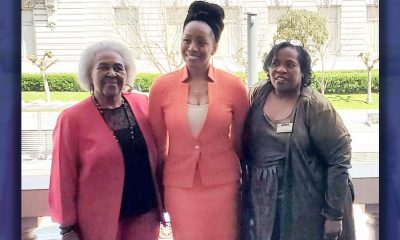California Black Media
Reports Cast Shadows on the Economic Picture for Black Californians
Recent studies suggest that the economic picture for Black Californians is not looking rosy. The state is becoming less affordable for African Americans, leading many families to relocate to less expensive places both within and past the borders.

By Lila Brown
California Black Media
Recent studies suggest that the economic picture for Black Californians is not looking rosy.
The state is becoming less affordable for African Americans, leading many families to relocate to less expensive places both within and past the borders.
“After pandemic-era declines, California’s poverty rate is on the rise. Expansions to safety net programs during the pandemic reduced poverty substantially, but these expansions had mostly expired by the end of 2022,” reads a report published by the Public Policy Institute of California (PPIC) on Oct. 24.
For Black Californians, the poverty rate at 13.6% is more than double the percentage of African Americans living in California, which currently stands at about 5.8% of nearly 40 million Californians.
“The state’s overall poverty rate increased from 11.7% in fall 2021 to 13.2% in early 2023,” the PPIC report continued.
The unemployment numbers for Black Californians also remain high — and continue to climb.
According to the Economic Policy Institute, the unemployment rate for Black Californians stands at 7.4%, which is higher than the state’s 4.5% total unemployment rate for the second quarter of 2023. This is also higher than the national rate of 5.8%.
In California, the Black-white unemployment ratio is at 1.9 to 1. The national Black-white unemployment ratio remained at 2 to 1 in the second quarter of 2023, maintaining the historic trend of Black workers being twice as likely to be unemployed as white workers. There’s nowhere in the country where the unemployment numbers for Black and white workers are equal.
For September, the California Employment Development Department (EDD) reported that unemployment was on the rise. The state’s unemployment rate crept up to 4.7%, an increase of 144,000 people. It is the second-highest unemployment rate of any state. The labor force — Californians working or looking for work — also shrank.
Between 2021 and 2022, the overall poverty rate in California rose from 11.0% to 16.4%. This increase can be linked to the high costs of living, inflation, and the end of pandemic-era supports. Financial assistance cut the poverty rate for Black Californians by one quarter to 9.5% in 2021, but it nearly doubled to 18.6% the year after.
U.S. Census data showed that 54% of Black Californians reported facing difficulty paying for essential needs like food and housing.
Los Angeles County (15.5%) and San Diego County (15.0%) had the highest poverty rates. The Central Valley and Sierra region had the lowest (10.7%), largely due to lower housing costs.
In China last week, Gov. Gavin Newsom highlighted the strength of California’s economy, the fifth-largest in the world, and President Joe Biden released his Bidenomics report in June highlighting the achievements of his Invest in America plan.
The White House reports that under the Biden-Harris Administration, Black Americans have experienced their lowest recorded unemployment rate and the highest employment rate since November 2000.
The participation of Black workers in the labor force has also reached its highest level since August 2008. The poverty rate for Black children has been reduced by more than 12%, impacting over 200,000 children, through the Thrifty Food Plan.
Most reports point to signs that the nation is at pre-pandemic levels and California has recovered its pandemic-induced job losses in June 2022, according to the latest California Labor Market Review released in August.
However, numbers indicating the state economy is strong contrast with the harsh realities confronting many Black Californians struggling to make ends meet.
A study by the Urban Institute shines light on the complex challenges Black Californians face as more decide to relocate to less expensive areas, driven by a combination of economic factors like housing unaffordability, rolling layoffs, rising inflation, increasing renter evictions, and stagnant salaries.
“This has been the reality of many Black Californians: As the Black populations of San Francisco and Alameda counties drop, those of Contra Costa and Sacramento rise. As Los Angeles sees its share of Black residents decline, neighboring Riverside and San Bernardino shares increase,” that report says.
Lisa D. Cook, governor of the Federal Reserve Board, says unemployment is the root of all of America’s social problems and pushing for maximum employment is the solution to minimizing poverty. Cook spoke while accepting the Louis E. Martin Award on Oct. 18 in Washington, D.C.
“Maximum employment boosts long-run economic potential. It means that a vital resource is being used productively. A strong labor market increases labor force participation and the willingness of firms to recruit and upgrade the skills of workers,” Cook stated.
“The full participation of all segments of society should be expected to result in more ideas, including more diverse ideas, more invention, and more innovation.”
Activism
Oakland Post: Week of April 24 – 30, 2024
The printed Weekly Edition of the Oakland Post: Week of April 24 – 30, 2024

To enlarge your view of this issue, use the slider, magnifying glass icon or full page icon in the lower right corner of the browser window. ![]()
Business
Black Business Summit Focuses on Equity, Access and Data
The California African American Chamber of Commerce hosted its second annual “State of the California African American Economy Summit,” with the aim of bolstering Black economic influence through education and fellowship. Held Jan. 24 to Jan. 25 at the Westin Los Angeles Airport Hotel, the convention brought together some of the most influential Black business leaders, policy makers and economic thinkers in the state. The discussions focused on a wide range of economic topics pertinent to California’s African American business community, including policy, government contracts, and equity, and more.

By Solomon O. Smith, California Black Media
The California African American Chamber of Commerce hosted its second annual “State of the California African American Economy Summit,” with the aim of bolstering Black economic influence through education and fellowship.
Held Jan. 24 to Jan. 25 at the Westin Los Angeles Airport Hotel, the convention brought together some of the most influential Black business leaders, policy makers and economic thinkers in the state. The discussions focused on a wide range of economic topics pertinent to California’s African American business community, including policy, government contracts, and equity, and more.
Toks Omishakin, Secretary of the California State Transportation Agency (CALSTA) was a guest at the event. He told attendees about his department’s efforts to increase access for Black business owners.
“One thing I’m taking away from this for sure is we’re going to have to do a better job of connecting through your chambers of all these opportunities of billions of dollars that are coming down the pike. I’m honestly disappointed that people don’t know, so we’ll do better,” said Omishakin.
Lueathel Seawood, the president of the African American Chamber of Commerce of San Joaquin County, expressed frustration with obtaining federal contracts for small businesses, and completing the process. She observed that once a small business was certified as DBE, a Disadvantaged Business Enterprises, there was little help getting to the next step.
Omishakin admitted there is more work to be done to help them complete the process and include them in upcoming projects. However, the high-speed rail system expansion by the California High-Speed Rail Authority has set a goal of 30% participation from small businesses — only 10 percent is set aside for DBE.
The importance of Diversity, Equity and Inclusion (DEI) in economics was reinforced during the “State of the California Economy” talk led by author and economist Julianne Malveaux, and Anthony Asadullah Samad, Executive Director of the Mervyn Dymally African American Political and Economic Institute (MDAAPEI) at California State University, Dominguez Hills.
Assaults on DEI disproportionately affect women of color and Black women, according to Malveaux. When asked what role the loss of DEI might serve in economics, she suggested a more sinister purpose.
“The genesis of all this is anti-blackness. So, your question about how this fits into the economy is economic exclusion, that essentially has been promoted as public policy,” said Malveaux.
The most anticipated speaker at the event was Janice Bryant Howroyd known affectionately to her peers as “JBH.” She is one of the first Black women to run and own a multi-billion-dollar company. Her company ActOne Group, is one of the largest, and most recognized, hiring, staffing and human resources firms in the world. She is the author of “Acting Up” and has a profile on Forbes.
Chairman of the board of directors of the California African American Chamber of Commerce, Timothy Alan Simon, a lawyer and the first Black Appointments Secretary in the Office of the Governor of California, moderated. They discussed the state of Black entrepreneurship in the country and Howroyd gave advice to other business owners.
“We look to inspire and educate,” said Howroyd. “Inspiration is great but when I’ve got people’s attention, I want to teach them something.”
California Black Media
Asm. Tina McKinnor Elected Chair of L.A. Delegation to Legislature
On Jan. 24, the members of the Los Angeles County Delegation (LACD) to the California Legislature elected Assemblymember Tina McKinnor (D-Inglewood) as the group’s chair. McKinnor, who is a member of the California Legislative Black Caucus, will lead the 39-member body, which is comprised of 15 State Senators and 24 State Assemblymembers representing various areas of Los Angeles County.

By California Black Media
On Jan. 24, the members of the Los Angeles County Delegation (LACD) to the California Legislature elected Assemblymember Tina McKinnor (D-Inglewood) as the group’s chair.
McKinnor, who is a member of the California Legislative Black Caucus, will lead the 39-member body, which is comprised of 15 State Senators and 24 State Assemblymembers representing various areas of Los Angeles County.
As LACD chair, McKinnor succeeds Assemblymember Luz Rivas (D-San Fernando Valley).
“I am grateful for the trust legislators from the Los Angeles County Delegation have placed in me to serve as its next Chair,” said McKinnor in a statement.
LACD Vice Chair, Sen. Maria Elena Durazo (D-Los Angeles), said the body, which collectively represents about 10 million people in California’s populous county, is the largest, bi-partisan, and most diverse delegation in the California Legislature.
“Heading into a challenging budget year, the Delegation, and I will be intensely focused on making sure communities throughout Los Angeles County receive the services they need and that we continue our historic investments to address homelessness and the housing affordability crisis in Los Angeles County,” Durazo added.
McKinnor thanked Rivas for her stewardship of the LACD during the last legislative session.
“The Delegation and I are grateful to outgoing Chair, Assemblymember Luz Rivas, for her incredible leadership to the Legislature, the state, and especially the people of Los Angeles County,” said McKinnor.
-

 Activism4 weeks ago
Activism4 weeks agoOakland Post: Week of March 27 – April 2, 2024
-

 #NNPA BlackPress4 weeks ago
#NNPA BlackPress4 weeks agoBeloved Actor and Activist Louis Cameron Gossett Jr. Dies at 87
-

 Community2 weeks ago
Community2 weeks agoFinancial Assistance Bill for Descendants of Enslaved Persons to Help Them Purchase, Own, or Maintain a Home
-

 Activism3 weeks ago
Activism3 weeks agoOakland Post: Week of April 3 – 6, 2024
-

 Business2 weeks ago
Business2 weeks agoV.P. Kamala Harris: Americans With Criminal Records Will Soon Be Eligible for SBA Loans
-

 Activism2 weeks ago
Activism2 weeks agoOakland Post: Week of April 10 – 16, 2024
-

 Community2 weeks ago
Community2 weeks agoAG Bonta Says Oakland School Leaders Should Comply with State Laws to Avoid ‘Disparate Harm’ When Closing or Merging Schools
-

 Community1 week ago
Community1 week agoOakland WNBA Player to be Inducted Into Hall of Fame




















































